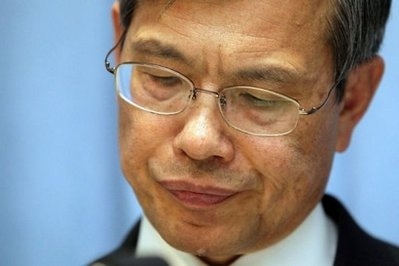The operator of Japan\'s ageing Hamaoka nuclear plant, located near a tectonic faultline southwest of Tokyo, said Monday it would temporarily shut down its last two running reactors.
 |
| Chubu Electric Power president Akihisa Mizuno gives a press conference at the company\'s headquarters in Nagoya in Aichi prefecture, central Japan. |
Prime Minister Naoto Kan Friday called for the closure of the plant, eight weeks after a massive quake and tsunami damaged the Fukushima Daiichi nuclear plant northeast of Tokyo, sparking the world\'s worst atomic crisis since Chernobyl in 1986.
Seismologists have long warned that a major quake is overdue in the Tokai region southwest of Tokyo where the Hamaoka plant is located. It is only 200 kilometres (125 miles) from the capital and megacity of Tokyo.
The Hamaoka plant has five reactor units, but only two are currently running -- numbers four and five. Reactors one and two, built in the 1970s, were stopped in 2009, and three is undergoing maintenance.
"We consider that the prime minister\'s request was very serious," Chubu Electric Power Co. president Akihisa Mizuno said after its board decided to stop the number four and five reactors and postpone the restart of number three.
He told a news conference that "we will implement reinforcement measures against tsunamis and explain them to regain public trust".
Kan welcomed the swift response as "satisfactory". "The government for itself will see to it that there will be no shortage of electricity overall," he told reporters at his official residence.
The Hamaoka plant accounts for almost 12 percent of the output of Chubu Electric, which services part of Japan\'s industrial heartland, including many Toyota auto factories.
Kan explained on Friday the plant should stay shut while a higher sea wall is built and other measures are taken to guard it against a major quake and tsunami. Local media said the suspension would last about two years.
Japanese anti-nuclear campaigners have long argued that the seismically unstable area, where two major continental plates meet, makes Hamaoka the most dangerous atomic facility in the quake-prone Japanese archipelago.
Japan, the world\'s number three economy, endures 20 percent of all major earthquakes and generates about 30 percent of its power from nuclear plants.
The record March tremor and wave which battered Japan\'s northeast coast caused 11 of Japan\'s 55 nuclear reactors to automatically shut down, while triggering a major crisis at the Fukushima plant.
Economy, Trade and Industry Minister Banri Kaieda said there was "no safety problem" at any other nuclear plants and they would continue operating as they are confirmed to have "adequate measures" in place.
Tens of thousands of people have been evacuated from a 20 kilometre zone around the Fukushima plant, which has leaked radiation into the air, soil and sea. Its operator, Tokyo Electric Power, expects to stabilise it in six to nine months.
Goshi Hosono, special adviser to Kan on nuclear policy, earlier Monday said he was confident Chubu could meet peak summer demand, when air-conditioner use rises steeply, by using idle thermal and hydro power.
"I think Chubu Electric can overcome this summer if it takes rational measures by using power stations which are now idle," he told a press conference.
On the centre-left government\'s energy policy, he said: "It is true that the earthquake and tsunami have clearly changed our perception. Otherwise we would not have urged the shutdown of the Hamaoka nuclear plant.
"The possibility that it will be hit by an earthquake and tsunami is much higher than that for any other nuclear plant."
He added that "we must take this very unfortunate catastrophe as a lesson to build a Japanese society strongly resistant to tsunamis. And I believe we can have the Tokai region fully prepared for a tsunami."

Leave your comment on this story